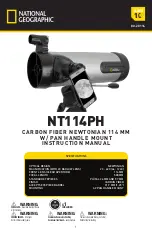
4. Getting Started
Balancing the Telescope
To insure smooth movement of the telescope on both axes of
the equatorial mount, it is imperative that the optical tube be
properly balanced. We will first balance the telescope with
respect to the R.A. axis, then the Dec. axis.
1. Keeping one hand on the telescope optical tube, loosen
the R.A. lock lever. Make sure the Dec. lock lever is locked,
for now. The telescope should now be able to rotate freely
about the R.A. axis. Rotate it until the counterweight shaft
is parallel to the ground (i.e., horizontal).
2. Now loosen both counterweight lock knobs and slide the
weights along the shaft until they exactly counterbalance the
telescope (Figure 2a). That’s the point at which the shaft
remains horizontal even when you let go of the telescope with
both hands (Figure 2b).
3. Retighten the counterweight lock knobs. The telescope is
now balanced on the R.A. axis.
4. To balance the telescope on the Dec. axis, first tighten the
R.A. lock lever, with the counterweight shaft still in the hor-
izontal position.
5. With one hand on the telescope optical tube, loosen the
Dec. lock lever. The telescope should now be able to
rotate freely about the Dec. axis. Loosen the tube ring
clamps a few turns, until you can slide the telescope tube
forward and back inside the rings (this can be aided by
using a slight twisting motion on the optical tube while you
push or pull on it) (Figure 2c).
6. Position the telescope so it remains horizontal when you
carefully let go with both hands. This is the balance point
(Figure 2d). Before clamping the rings tight again, rotate
the telescope so the eyepiece is at a convenient angle for
viewing. When you are actually observing with the tele-
scope, you can adjust the eyepiece position by loosening
the tube rings and rotating the optical tube.
7. Retighten the tube ring clamps.
The telescope is now balanced on both axes. Now when you
loosen the lock lever on one or both axes and manually point
the telescope, it should move without resistance and should
not drift from where you point it.
5
b.
d.
c.
a.
Figure 2. Proper operation of the equatorial mount requires that the telescope tube be balanced on both the R.A. and Dec. axes. (a) With the
R.A. lock lever released, slide the counterweights along the counterweight shaft until they just counterbalance the tube. (b) When you let go
with both hands, the tube should not drift up or down. (c) With the Dec. lock lever released, loosen the tube ring clamps a few turns and slide
the telescope forward or back in the tube rings. (d) When the tube is balanced about the Dec. axis, it will not move when you let go.
(Model shown is SkyView Deluxe 8".)





























